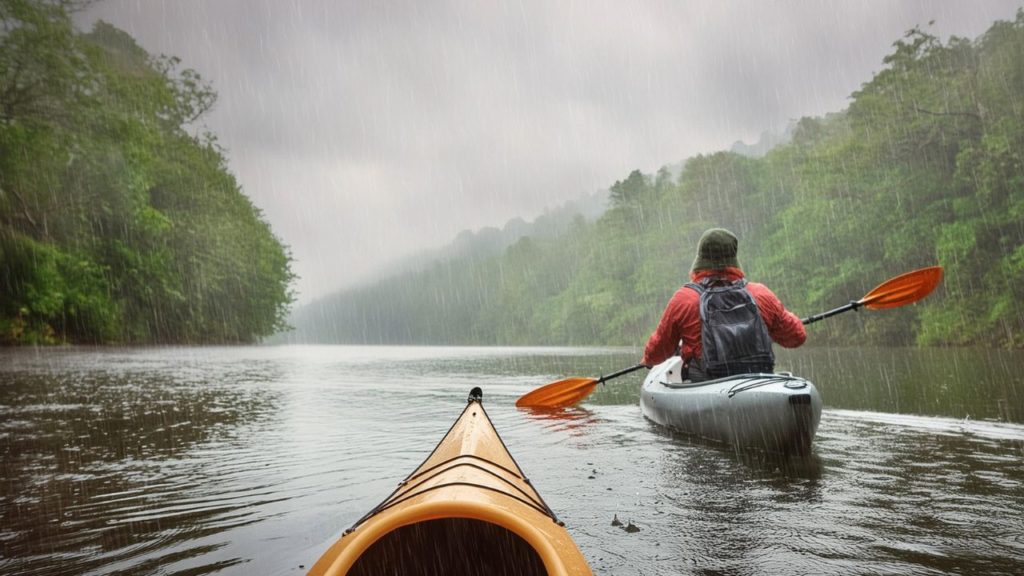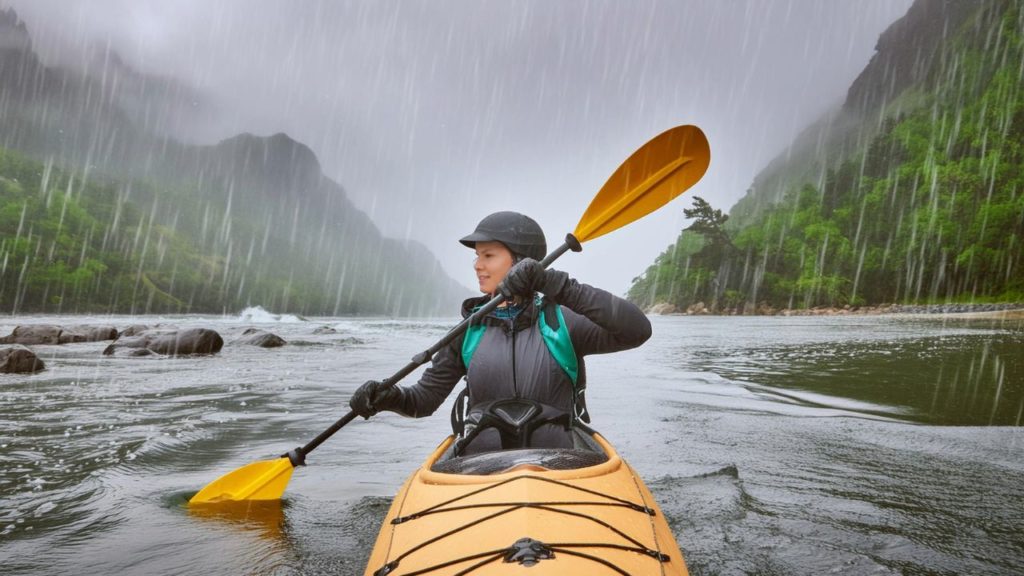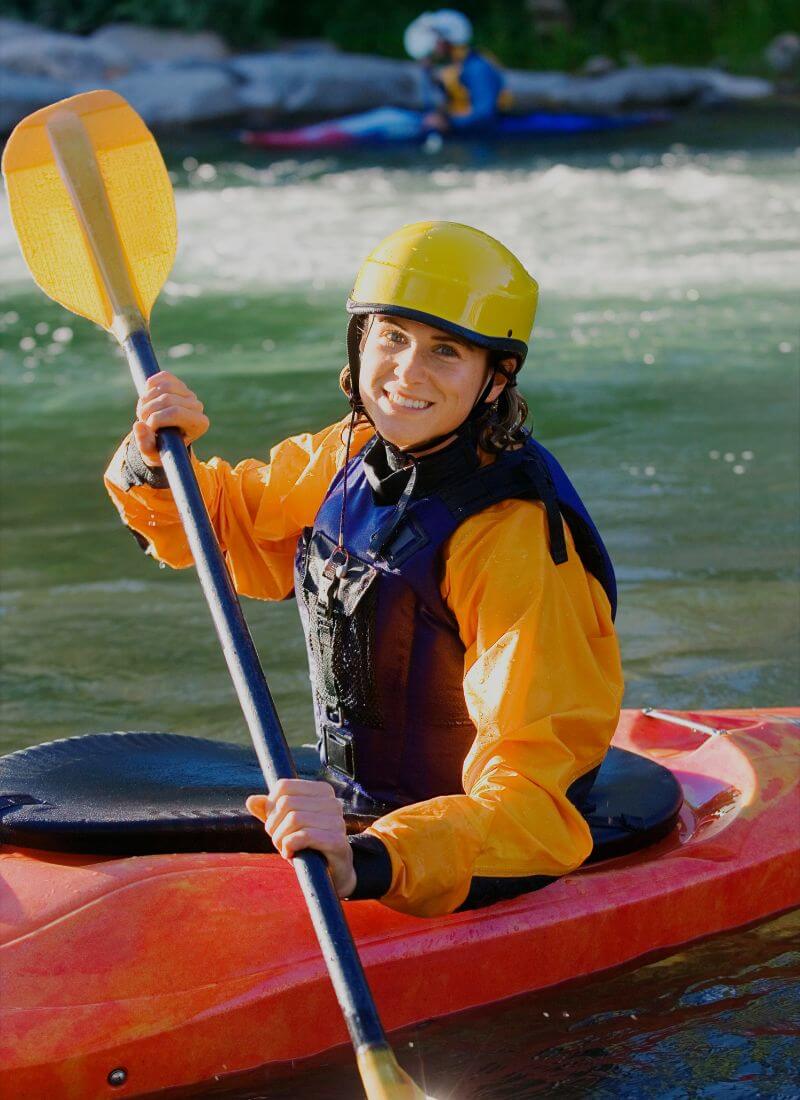Many beginner kayakers may wonder if it is safe or enjoyable to kayak in the rain. With proper preparation, kayaking in light rain can still be a fun, rewarding experience. Kayakers should take some extra precautions and dress appropriately for wet weather. It’s also important to keep safety in mind and avoid paddling in certain high-risk stormy conditions.
With the right gear and some practical tips, kayakers can continue enjoying the sport even when the weather takes a turn for the wet. Kayaking in the rain can provide memorable adventures and new challenges to experienced paddlers. This article provides key considerations for safely kayaking and having fun when the skies turn gray.
Is Kayaking In The Rain Safe?
Yes, Kayaking in the rain can be perfectly safe if you take the proper precautions. However, there are some risks to be aware of. The main concerns with kayaking in wet weather are the chances of capsizing and hypothermia.
When it rains, kayaking conditions can become more hazardous. The water may have more waves, wind, and choppiness. This makes it easier for your kayak to capsize, especially if you lack experience or proper technique. Even the most seasoned kayakers can flip over if conditions get rough enough.

Capsizing leads to the risk of hypothermia. Falling into cold water can quickly lower your body temperature. Being wet also accelerates heat loss. Hypothermia occurs when your core temperature drops below 95°F (35°C). It impairs your muscle function, mental abilities, and can lead to death if severe. Wearing the right gear is crucial to prevent hypothermia while kayaking in the rain.
If you want to kayak in the rain, you should prepare first to ensure you can enjoy it safely. Let’s prepare the kayak.
Preparing Your Kayak For Rain
Kayaking in light rain can be an enjoyable experience if you properly prepare your kayak. Two key areas to address are spray skirts and drainage plugs.
Spray Skirts
A spray skirt is a waterproof cover that seals the cockpit area around your waist to prevent water from entering. For kayaking in rain, ensure your spray skirt is in good condition with no rips or tears. The seal around the cockpit should fit snugly to keep water out. Neoprene or nylon spray skirts work well. Bring an extra spray skirt in case the one you’re wearing gets excessively wet.
Drainage Plugs
All kayaks should have drainage plugs installed in the stern and bow to allow water to drain out. Make sure these plugs are securely in place before paddling in rain. Consider replacing standard plastic drainage plugs with rubber ones, which form a tighter seal to keep water out. Carry extra drainage plugs as a precaution.
Check over the kayak for any cracks or holes where water could enter. Seal these up with marine-grade waterproof tape or sealant. With the right preparations, your kayak can handle wet weather paddling while keeping you dry inside.
What To Wear Kayaking In Rain?
When you’re kayaking in the rain, it’s essential to wear the right clothing to stay comfortable and dry. Here are some helpful tips on what to wear:
Wetsuits
Wetsuits are a good option for kayaking in light to moderate rain. The neoprene material will keep your body insulated from the cold water while allowing some water in to warm up. Look for wetsuits with tighter seals around the wrists, ankles, and neck to prevent excessive water flushing. A wetsuit will also provide buoyancy if you capsize. Pick either a full wetsuit or a two-piece wetsuit depending on the weather.
Drysuits
For kayaking in heavy rain or cold water, a drysuit is recommended. Drysuits keep you totally dry by sealing tightly around your wrists, ankles, and neck to keep water out completely. Quality drysuits are made of waterproof and breathable fabrics like Gore-Tex. The drysuit keeps you warm and dry by trapping a thin layer of air close to your body. Look for integrated socks and latex gaskets for the best waterproofing. Wear plenty of insulating layers underneath the drysuit.

Paddle Jackets
Paddle jackets, also called spray jackets or cagoules, provide water-resistance without the bulk of a full drysuit. These lightweight jackets are made of waterproof, breathable fabric. They feature elastic wrists and a high collar to keep water out. Paddle jackets work well for kayaking in light rain and choppy waves when you expect to get splashed but not submerged. Layer them over your wetsuit or regular paddling clothes for extra protection.
Safety Gear For Kayaking In Rain
When you kayak in the rain, having the right safety gear can make you feel safer. Two important things to bring are a bilge pump and a paddle float.
Bilge Pump
To remove water from your kayak, you should have a bilge pump . Rain can quickly lead to water accumulation in your boat from precipitation, splash from your paddle, or waves. A hand-operated bilge pump allows you to pump water out through the scupper holes in your kayak. This keeps your kayak from getting waterlogged. Bring a spare bilge pump as a backup in case your first one fails.
Paddle Float
A paddle float attaches to the end of your paddle blade to create an outrigger that provides stability if you capsize. To use it, place the paddle float on the blade and push it under the surface while holding the other paddle blade vertically. The float will stabilize you as you reenter the kayak. A paddle float is an essential wet exit and reentry tool for kayaking in rain where you are more likely to capsize.
Paddling Techniques For Rainy Conditions
Kayaking in the rain needs some changes to how you paddle to stay in control and move efficiently. First, lean forward in your kayak seat to see better since sitting upright can block your view with your rain jacket hood. Leaning forward helps you see and keeps you more stable.
Second, plant your paddle firmly with each stroke because the rain can make it slippery. Grip it tightly and use your core and back muscles to make strong strokes, so your paddle doesn’t slip and lose power. Third, take slightly wider strokes to increase your leverage. This uses more muscles and gives your paddle a better grip in the water, helping you paddle straight even in windy conditions. Practicing these simple changes will help you paddle well and stay on course, even in heavy rain.
Where To Kayak In The Rain?
Kayaking in the rain can be fun and rewarding if done safely, but the type of water you choose is important. Flatwater kayaking on lakes, ponds, canals, or other calm waters is usually safe in light to moderate rain because the water stays calm and you can see well, with raindrops creating interesting ripple effects. Proper rain gear and staying close to shore can help keep you safe, even if higher winds or choppy waves happen.

On the other hand, whitewater kayaking on rivers or streams is more challenging in the rain, as it can quickly turn calm rivers into fast-moving rapids, increase water volume and speed, and sweep debris downstream, making it harder to see obstacles. Only kayak on rivers you know well in the rain, and always check rapids carefully.
When To Avoid Kayaking In Heavy Rain?
Kayaking in heavy rain and thunderstorms can be dangerous, so it’s important to be careful. Avoid kayaking when thunderstorms are expected or happening because lightning can strike even far from where it’s raining. When you hear thunder, go to shore immediately. Wait for at least 30 minutes after the last rumble before you start paddling again. After heavy rain, rivers and streams can rise quickly and flow faster, making it risky to kayak.
Wait until water levels go down and conditions improve before going out. Strong winds, especially over 10 mph or close to gale force, can also make kayaking unsafe by pushing you off course or flipping your boat. Lastly, avoid kayaking in heavy rain or fog when it’s hard to see well. Wait for better weather and clearer visibility before going out on the water. Always prioritize safety and watch out for weather conditions to have a safer and more enjoyable kayaking trip.
Conclusion
Kayaking in the rain can be both exciting and risky, depending on how well you prepare. It’s important to wear the right gear, like spray skirts or waterproof jackets, to stay dry and safe. Avoid going out during thunderstorms because of the danger of lightning. After heavy rain, wait for the water levels to go down before paddling. Strong winds can also make kayaking tricky, so be cautious. By being prepared and staying aware of the weather, you can enjoy kayaking in the rain while keeping yourself safe.
Also Read:

